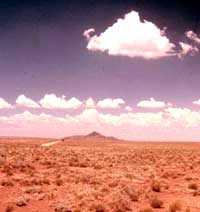What is herding?
Herder societies are also known as pastoral societies and were also nomadic, like hunter-gatherers. They kept domesticated animals and generally lived in areas that were too dry to grow crops. They would also move to a new settlement when food became scarce in their area.
Who were the herders?
The first herders, or pastoralists, in southern Africa were the Khoikhoi. They were also called Hottentots, but also called themselves the Khoikhoi, meaning “men of men” or “the real people” because they were proud of their past and culture.
Where did they come from?
It is difficult to say where the Khoikhoi came from, but they arrived in southern Africa from further north around 2 000 years ago. They brought a new way of life to this area and the San, who were hunter-gatherers didn't always understand them. This led to conflict between the two groups.
Pastoral way of life
The Khoikhoi kept herds of animals like goats, cattle and sheep and had to move around to find enough grazing for their animals. They moved according to the season and only stayed in one place for a few weeks. This meant that they had to be able to carry all their belongings themselves or load them onto the backs of their animals.
Houses had to very light and easy to erect and dismantle. For this reason they were made of thin poles covered with reed mats. Even pots and buckets were made of wood with small handles to make them easier to tie to animals' backs. They also wore clothes made of leather, like the San.
The animals, especially cattle, were a sign of wealth and the Khoikhoi only ate cattle that had died or had been stolen from their enemies. They only killed their own animals for important occasions like funerals or weddings. The women milked the animals and gathered wild plants from the veld and the men killed game for everyday food. This means that the Khoikhoi haunted and gathered, but also herded animals.
Khoikhoi society had rich and poor people because animals could belong to individuals. They provided food, clothes and transport and were very important. This was completely different from the San, who were all the same and shared everything. Rich Khoikhoi people would share their milk with poorer members of their group, but would still be considered more important. They would also rub animal fat over their bodies to show their wealth.
Note to teachers: SAHO is still developing content for this section
How San and Khoikhoi shared the same landscape
 The Khoikhoi's herds exhausted the land and the game the San normally relied on to survive left. This caused them to steal the Khoikhoi's herds, which sparked a war that lasted for hundreds of years. Source: www.cpluhna.nau.edu
The Khoikhoi's herds exhausted the land and the game the San normally relied on to survive left. This caused them to steal the Khoikhoi's herds, which sparked a war that lasted for hundreds of years. Source: www.cpluhna.nau.edu
The Khoikhoi and San lifestyles were very different and, because the groups lived close to each other, they soon started fighting. The main reason for their conflict was the limited amount of game available. The Khoikhoi were animal herders, but they still hunted and there weren't enough for both groups. The domesticated animals also started eating too much grass and drove the wild animals away. This caused the San to go hungry and they began killing the Khoikhoi's animals for food. This situation resulted in a war that lasted for hundreds of years.
The fighting and other contact between the two groups had serious effects on both. The Khoikhoi made larger groups to protect themselves against the San. Some of the San made peace with their enemies and joined their communities, some kept on fighting and moved to the mountains and deserts, while others formed groups of robbers that raided Khoikhoi herds.